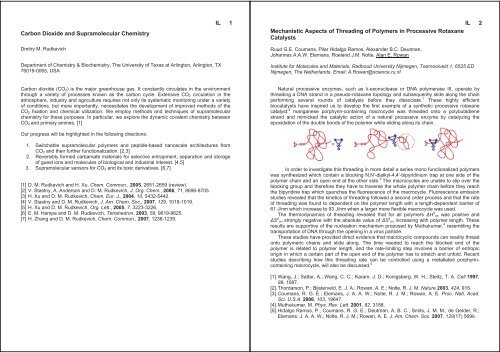ISMSC 2007 - Università degli Studi di Pavia
ISMSC 2007 - Università degli Studi di Pavia
ISMSC 2007 - Università degli Studi di Pavia
You also want an ePaper? Increase the reach of your titles
YUMPU automatically turns print PDFs into web optimized ePapers that Google loves.
Carbon Dioxide and Supramolecular Chemistry<br />
Dmitry M. Rudkevich<br />
Department of Chemistry & Biochemistry, The University of Texas at Arlington, Arlington, TX<br />
76019-0065, USA<br />
Carbon <strong>di</strong>oxide (CO2) is the major greenhouse gas. It constantly circulates in the environment<br />
through a variety of processes known as the carbon cycle. Extensive CO2 circulation in the<br />
atmosphere, industry and agriculture requires not only its systematic monitoring under a variety<br />
of con<strong>di</strong>tions, but more importantly, necessitates the development of improved methods of the<br />
CO2 fixation and chemical utilization. We employ methods and techniques of supramolecular<br />
chemistry for these purposes. In particular, we explore the dynamic covalent chemistry between<br />
CO2 and primary amines. [1]<br />
Our progress will be highlighted in the following <strong>di</strong>rections:<br />
1. Switchable supramolecular polymers and peptide-based nanoscale architectures from<br />
CO2 and their further functionalization. [2,3]<br />
2. Reversibly formed carbamate materials for selective entrapment, separation and storage<br />
of guest ions and molecules of biological and industrial interest. [4,5]<br />
3. Supramolecular sensors for CO2 and its toxic derivatives. [6,7]<br />
[1] D. M. Rudkevich and H. Xu, Chem. Commun., 2005, 2651-2659 (review).<br />
[2] V. Stastny, A. Anderson and D. M. Rudkevich, J. Org. Chem., 2006, 71, 8696-8705.<br />
[3] H. Xu and D. M. Rudkevich, Chem. Eur. J., 2004, 10, 5432-5442.<br />
[4] V. Stastny and D. M. Rudkevich, J. Am. Chem. Soc., <strong>2007</strong>, 129, 1018-1019.<br />
[5] H. Xu and D. M. Rudkevich, Org. Lett., 2005, 7, 3223-3226.<br />
[6] E. M. Hampe and D. M. Rudkevich, Tetrahedron, 2003, 59, 9619-9625.<br />
[7] H. Zhang and D. M. Rudkevich, Chem. Commun., <strong>2007</strong>, 1238-1239.<br />
IL 1<br />
Mechanistic Aspects of Threa<strong>di</strong>ng of Polymers in Processive Rotaxane<br />
Catalysts<br />
Ruud G.E. Coumans, Pilar Hidalgo Ramos, Alexander B.C. Deutman,<br />
Johannes A.A.W. Elemans, Roeland J.M. Nolte, Alan E. Rowan<br />
Institute for Molecules and Materials, Radboud University Nijmegen, Toernooiveld 1, 6525 ED<br />
Nijmegen, The Netherlands. Email: A.Rowan@science.ru.nl<br />
IL 2<br />
Natural processive enzymes, such as -exonuclease or DNA polymerase III, operate by<br />
threa<strong>di</strong>ng a DNA strand in a pseudo-rotaxane topology and subsequently slide along the chain<br />
performing several rounds of catalysis before they <strong>di</strong>ssociate. 1 These highly efficient<br />
biocatalysts have inspired us to develop the first example of a synthetic processive rotaxane<br />
catalyst: 2 manganese porphyrin-containing macrocycle was threaded onto a polybuta<strong>di</strong>ene<br />
strand and mimicked the catalytic action of a natural processive enzyme by catalyzing the<br />
epoxidation of the double bonds of the polymer while sli<strong>di</strong>ng along its chain.<br />
In order to investigate this threa<strong>di</strong>ng in more detail a series mono functionalized polymers<br />
was synthesized which contain a blocking N,N’-<strong>di</strong>alkyl-4,4’-bipyri<strong>di</strong>nium trap at one side of the<br />
polymer chain and an open end at the other side. 3 The macrocycles are unable to slip over the<br />
blocking group and therefore they have to traverse the whole polymer chain before they reach<br />
the bipyri<strong>di</strong>ne trap which quenches the fluorescence of the macrocycle. Fluorescence emission<br />
stu<strong>di</strong>es revealed that the kinetics of threa<strong>di</strong>ng followed a second order process and that the rate<br />
of threa<strong>di</strong>ng was found to dependent on the polymer length with a length-dependent barrier of<br />
61 J/nm which increase to 93 J/nm when a larger more flexible macrocycle was used.<br />
The thermodynamics of threa<strong>di</strong>ng revealed that for all polymers H ‡ on was positive and<br />
S ‡ on strongly negative with the absolute value of S ‡ on increasing with polymer length. These<br />
results are supportive of the nucleation mechanism proposed by Muthukumar, 4 resembling the<br />
transportation of DNA through the opening in a virus particle.<br />
These stu<strong>di</strong>es have provided <strong>di</strong>rect evidence that macrocyclic compounds can rea<strong>di</strong>ly thread<br />
onto polymeric chains and slide along. The time needed to reach the blocked end of the<br />
polymer is related to polymer length, and the rate-limiting step involves a barrier of entropic<br />
origin in which a certain part of the open end of the polymer has to stretch and unfold. Recent<br />
stu<strong>di</strong>es describing how this threa<strong>di</strong>ng rate can be controlled using a metallated porphyrincontaining<br />
macrocycle, will also be <strong>di</strong>scussed. 5<br />
[1]. Wang, J.; Sattar, A.; Wang, C. C.; Karam, J. D.; Konigsberg, W. H.; Steitz, T. A. Cell 1997,<br />
89, 1087.<br />
[2]. Thordarson, P.; Bijsterveld, E. J. A.; Rowan, A. E.; Nolte, R. J. M. Nature 2003, 424, 915.<br />
[3]. Coumans, R. G. E.; Elemans, J. A. A. W.; Nolte, R. J. M.; Rowan, A. E. Proc. Natl. Acad.<br />
Sci. U.S.A. 2006, 103, 19647.<br />
[4]. Muthukumar, M. Phys. Rev. Lett. 2001, 82, 3188.<br />
[5]. Hidalgo Ramos, P.; Coumans, R. G. E.; Deutman, A. B. C.; Smits, J. M. M.; de Gelder, R.;<br />
Elemans, J. A. A. W.; Nolte, R. J. M.; Rowan, A. E. J. Am. Chem. Soc. <strong>2007</strong>, 129(17) 5699.

















